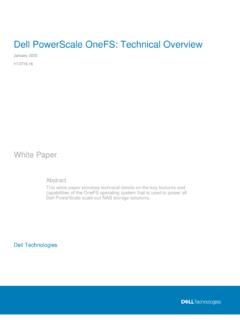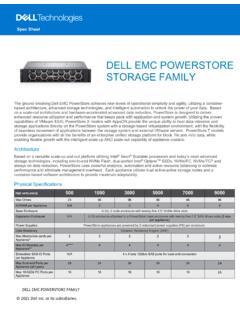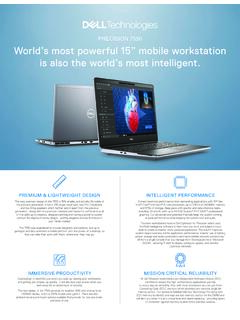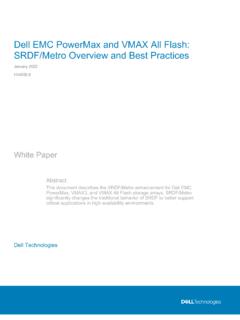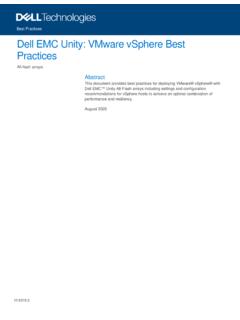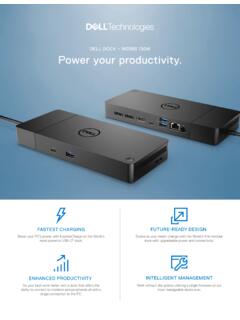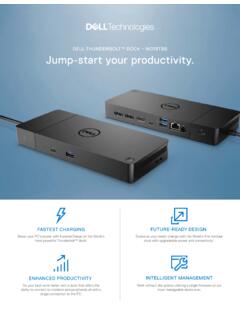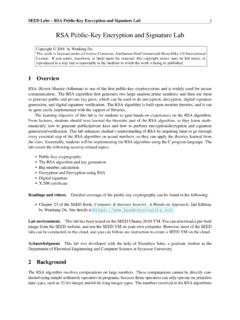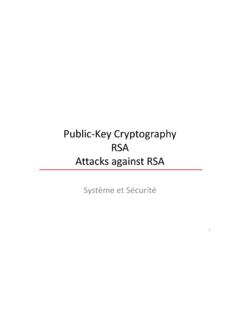Transcription of Dell EMC Unity: Data at Rest Encryption
1 Technical White Paper Dell EMC Unity: Data at Rest Encryption A Detailed Review Abstract This white paper explains the Data at Rest Encryption feature, which provides controller-based Encryption of data stored on Dell EMC Unity storage systems to protect against unauthorized access to lost or stolen drives or system. The Encryption technology as well as its implementation on Dell EMC Unity storage systems are discussed. June 2021. Revisions Revisions Date Description May 2016 Initial release Unity OE July 2017 Updated for Unity OE June 2021 Template and format updates. Updated for Unity OE Acknowledgments Author: Ryan Poulin The information in this publication is provided as is. Dell Inc. makes no representations or warranties of any kind with respect to the information in this publication, and specifically disclaims implied warranties of merchantability or fitness for a particular purpose. Use, copying, and distribution of any software described in this publication requires an applicable software license.
2 This document may contain certain words that are not consistent with Dell's current language guidelines. Dell plans to update the document over subsequent future releases to revise these words accordingly. This document may contain language from third party content that is not under Dell's control and is not consistent with Dell's current guidelines for Dell's own content. When such third party content is updated by the relevant third parties, this document will be revised accordingly. Copyright 2016-2021 Dell Inc. or its subsidiaries. All Rights Reserved. Dell Technologies, Dell, EMC, Dell EMC and other trademarks are trademarks of Dell Inc. or its subsidiaries. Other trademarks may be trademarks of their respective owners. [6/17/2021] [Technical White Paper] [ ]. 2 Dell EMC Unity: Data at Rest Encryption | Table of contents Table of contents Acknowledgments ..2. Table of contents ..3. Executive summary ..4. Audience ..4. 1 Terminology ..5. 2 Data Encryption Keys ..6.
3 Key Encryption Key ..7. Key Encryption Key Wrapping SATA Encryption ..7. FIPS 140-2 Validation ..7. External key management ..7. 3 Encryption procedures ..9. Enabling D@RE ..9. Enabling external key management ..11. Keystore backup ..13. Keystore restoration ..14. AuditLog and Checksum retrieval ..14. 4 Hardware replacements ..16. Data in flight ..16. Performance & capacity ..16. Encryption conversions ..17. 5 Conclusion ..18. A Technical support and resources ..19. Related 3 Dell EMC Unity: Data at Rest Encryption | Executive summary Executive summary With data security concerns at an all-time high, it is no surprise companies continue to place a premium on ensuring sensitive data is protected from unauthorized access. Whether it is due to internal policies or external compliance, securing data continues to be a high priority for organizations of all sizes. Dell EMC. Unity storage systems address these concerns through controller-based Data at Rest Encryption (D@RE), which encrypts stored data as it is written to disk.
4 Whether drives are lost, stolen, or failed, unauthorized access is prevented by rendering the drive unreadable without the Encryption key within the storage system. In addition to peace of mind, D@RE offers additional benefits including regulatory compliance, secure decommissioning, and the possibility to eliminate the need for physical drive shredding. D@RE is enabled by license file on Dell EMC Unity storage systems, and, is designed to be largely invisible to administrative end users, requiring almost no effort to enable or manage. Enabling the feature or backing up the Encryption keys externally takes just seconds, and redundant keystore backups stored on array ensures that user data is always as available as it is secure. Whether seeking to secure data as part of an internal security initiative, or to comply with government regulations, Dell EMC Unity D@RE ensure all user data is kept safe and secure against unauthorized disk access. As of Dell EMC Unity OE version , the system supports external key management through use of the Key Management Interoperability Protocol (KMIP).
5 This allows the system to offload an ignition key to an external key management application ensuring additional protection in case an entire system is lost or stolen whereby unauthorized access is prevented without the ignition key. For a list of supported external key managers, review the Dell EMC Unity Family Simple Support Matrix on Dell EMC Online Support. Audience This white paper is intended for Dell EMC customers, partners, and employees who are interested in learning about the Data at Rest Encryption functionality for securing user data on Dell EMC Unity storage systems. It assumes the reader has general IT experience, including knowledge as a system or network administrator. 4 Dell EMC Unity: Data at Rest Encryption | Audience 1 Terminology Background Zeroing: A background process that zeroes new drives when they are inserted into the system. Controller-Based Encryption (CBE): Encryption of data occurring within the SAS controller before being sent to disk. Data at Rest Encryption (D@RE): The process of encrypting data and protecting it against unauthorized access unless valid keys are provided.
6 This prevents data from being accessed and provides a mechanism to quickly crypto-erase data. Data Encryption Key (DEK): A randomly generated key that is used to encrypt data on a disk. For Dell EMC. Unity, there is a unique key for every bound drive. Key Encryption Key (KEK): A randomly generated key that encrypts (wraps) Data Encryption Keys to protect them as they travel from the Key Manager to the SAS controller. It is passed to the SAS controller at system start up and is protected by the KEK Wrapping Key. When external key management is enabled, the KEK acts as the ignition key and is migrated off the system to the remote key management server. Key Management Interoperability Protocol (KMIP): Developed and standardized by OASIS, a global nonprofit consortium for standards on security, KMIP is an extensible communication protocol that defines message formats for the manipulation of cryptographic keys on a key management server. KEK Wrapping Key (KWK): A randomly generated key that is generated and persisted to the SAS.
7 Encryption module upon installation of a D@RE enabled license. It's used to wrap the KEK as it travels from the Key Manager to the SAS controller. Keystore: An embedded and independently encrypted container which holds all D@RE Encryption keys on the array. Sanitization: The process of removing data from media to prevent it from being recovered. SAS (Serial Attached SCSI) Controller: The device that manages the SAS bus that is connected to the drives. On Dell EMC Unity systems, this is embedded on the storage processor and on 12Gb/s SAS I/O. Modules. Solid State Drive (SSD): A device that uses flash memory chips, instead of rotating platters, to store data. Also known as a Flash drive. Scrubbing: The process of writing random data to unused space on drives or zeroing unbound drives to erase residual data from previous use. Self-Encrypting Drive (SED): A drive that has built-in electronics to encrypt all data before it is written to the storage medium and decrypts the same data before it is read.
8 Storage Pool: A single repository of homogeneous or heterogeneous physical drives from which LUNs may be created. Storage Processor (SP): A hardware component that manages the system I/O between hosts and the drives. Unisphere: The management interface for creating, managing, and monitoring Dell EMC Unity storage systems. 5 Dell EMC Unity: Data at Rest Encryption | Audience 2 Overview Dell EMC Unity Data at Rest Encryption (D@RE) protects against unauthorized access to lost, stolen, or failed drives by ensuring all sensitive user data on the system is encrypted as it is written to disk. It does this through hardware-based Encryption modules located in the SAS controllers and 12Gb/s SAS I/O modules which encrypt data as it is written to the backend drives, and decrypt data as it is retrieved from these drives. Because of the controller-based approach, Dell EMC Unity D@RE supports all drive types currently supported in Dell EMC Unity storage systems, and those that will be offered in the future.
9 This offers an advantage over the self-encrypting drives offered by some other storage systems, which only exist in certain capacities, can be more expensive than regular drives, and must be qualified individually by storage vendors. Additionally, controller-based D@RE has minimal performance impact for typical mixed workloads, and no impact to other Dell EMC Unity data services due to the level at which the Encryption is performed, which is after all data services have been applied. For key generation and management, Dell EMC Unity D@RE by default uses an internal, fully-automated key manager. This key manager has several responsibilities including generating keys using RSA BSAFE , storing keys in a secure keystore, monitoring drive status changes that result in key creating/deletion, and Encryption of all data Encryption keys prior to moving them within the array. For all Encryption operations, Dell EMC Unity D@RE utilizes symmetric Encryption and does not use public-key Encryption (also known as asymmetric key Encryption ).
10 Dell EMC Unity D@RE data security is achieved through the combined use of several Encryption keys, which together ensure that neither the drives themselves, nor the keys which encrypt these drives, can be read by unauthorized parties finding themselves in possession of drives that have been removed from the storage system. The three types of Encryption keys used are referred to as the Data Encryption Keys (DEK), Key Encryption Key (KEK), and Key Encryption Key Wrapping Key (KWK). Information about how data is encrypted and secured on the system using these keys is described below. As of Dell EMC Unity OE version , the D@RE feature functionality has been extended to offer external key management as an additional security option. Utilizing external key management gives the additional benefit of preventing unauthorized access in the event where an entire Dell EMC Unity system including drives is lost or stolen. Data Encryption Keys A Data Encryption Key (DEK) is a 512-bit randomly generated key that is used to encrypt data on a particular drive.

